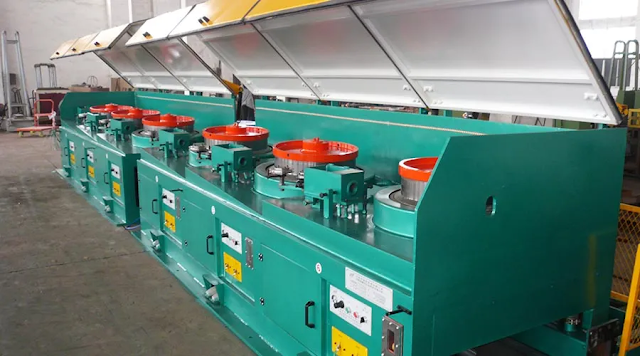Variable-frequency Drive Wire Drawing Machine Application
1. Device Overview
The high-speed wire drawing machine is mainly used for drawing copper wire. Its main electrical transmission part consists of a drafting motor, a take-up motor, and a wire arrangement motor.
Other auxiliary parts of the equipment include a swing bar (tension frame), positioning wheel, line dividing wheel, reciprocating wire arrangement rod, etc.
The drafting motor drives the drawing wheel to operate. The four-stage drawing wheel is linked through the belt to realize metal stretching, and the take-up motor realizes winding.
The equipment overview and functional requirements are as follows:
1.1 Basic parameters of equipment:
Product name: High speed thin wire drawing machine
Drafting motor (KW): 11/4P
Take-up motor (KW): 4/4P
Incoming wire diameter (mm): Φ0.6-1.20
Outlet wire diameter (mm): Φ0.08-0.32
Maximum mechanical speed (m/s): 2500(max)
Tension frame resistance value: 5KΩ
1.2 Technical specifications and requirements:
◎ Synchronization requirements when the equipment starts to increase speed;
◎ Keep the tension constant when the equipment is running;
◎ Synchronization is required when parking, without wire breakage or tension relaxation;
◎ Disconnection protection required for equipment safety production;
◎ Inching threading function
◎ External button starts operation;
◎ Running speed display;
◎ The diameter ratio of the winding empty disk to the full disk is about 1:3;
◎ Full plate weight is about 50kg;
◎The maximum operating frequency is about 70HZ.
2. System composition
◎ According to the equipment conditions, select the following models and components as electrical transmission equipment
INV1: Drafting VFD (Variable-frequency Drive) Sunwoele HSF600
INV2: Winding VFD (Variable-frequency Drive) Sunwoele HFV3000
Braking resistor: 1000W/80Ω
◎ The drafting motor adopts Sunwoele HSF600 VFD (Variable-frequency Drive), and the winding motor adopts HFV3000 winding-specific VFD (Variable-frequency Drive) (with external braking resistor)
The operation command and output frequency signal of the host INV1 is used as the operation command and frequency command of the slave INV2 to achieve synchronous operation.
◎ When parking, brake in the opposite direction for a heavy disc to prevent wire breakage caused by inertia.
◎ Use the JOG function to realize the jogging function during threading operations
◎ The pendulum output voltage signal is used as the feedback signal for internal variable PID correction control, and VFD (Variable-frequency Drive) unique winding curve is used for speed prediction graphic operation to achieve constant linear speed winding to meet process requirements.
◎ The pendulum output voltage signal is used as the feedback signal for internal variable PID correction control, and VFD (Variable-frequency Drive) unique winding curve is used for speed prediction graphic operation to achieve constant linear speed winding to meet process requirements.
3. Conclusion
During the entire working process of the high-speed thin wire drawing machine, the process requirements are mainly to maintain constant tension during winding.
Especially during high-speed operation and rewinding, there are higher requirements for the acceleration and deceleration synchronization control of VFD (Variable-frequency Drive) and the control of the inertia of the rewinding wheel during deceleration and parking.
After debugging and running, series VFD (Variable-frequency Drive) meets the user's process requirements during acceleration and deceleration operation, high-speed operation, and parking braking.
In order to meet the requirements for safe production, the disconnection protection function of the series VFD (Variable-frequency Drive), in addition to the normal set correction amount holding area, the winding VFD (Variable-frequency Drive) uses the frequency value given by INV1 As a reference value, the PID adjustment effect caused by the action of the tension frame is limited.





















